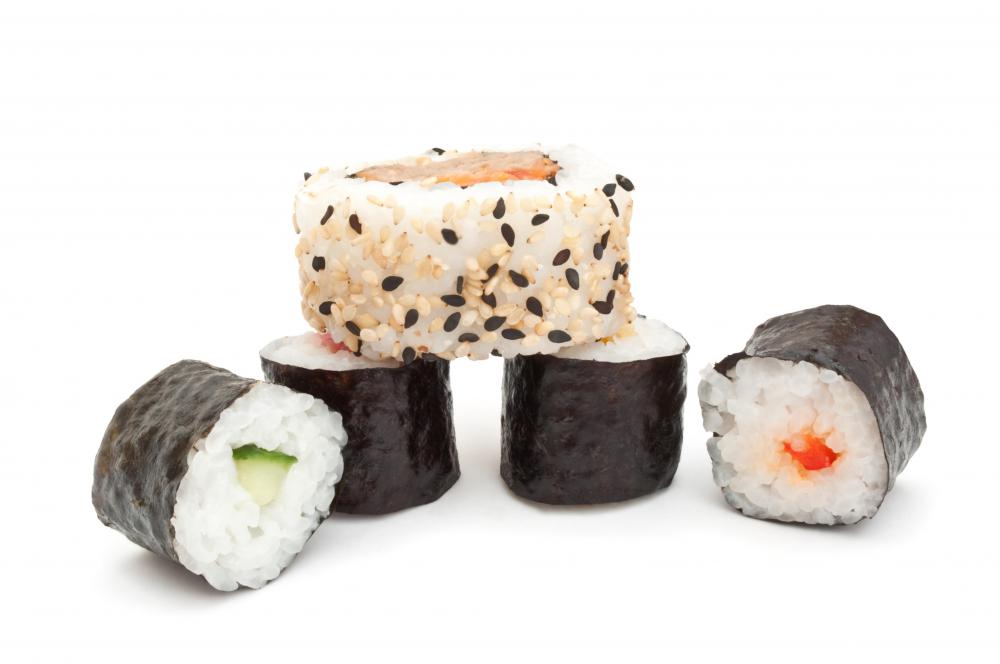At WiseGEEK, we're committed to delivering accurate, trustworthy information. Our expert-authored content is rigorously fact-checked and sourced from credible authorities. Discover how we uphold the highest standards in providing you with reliable knowledge.
What Are the Best Tips for Making Sushi Rice in a Rice Cooker?
The best tips for making sushi rice in a rice cooker generally concern choices that are made before the rice is even started: what kind of rice to use, how high to fill the water, and paying attention to overall cook time are among the most important. Using a rice cooker is generally the best way to make sushi rice. It is not foolproof, however. Success depends on selecting an appropriate rice, as well as following all of the rice cooker directions. Creating a perfect sticky rice may take some practice and experimentation, but knowing where to start will make the process easier.
Choosing the proper rice variety is one of the important parts of making sushi rice in a rice cooker. There are many different types of rice, but only a few will make successful sushi rice. Short grain white varieties are usually the best, though medium-grain will often work, as well. Instant rice or converted rice should be avoided.
One of the best parts of using a rice cooker is efficiency. The rice will cook without requiring much, if any, user interaction. Still, no appliance can do absolutely everything. Rinsing the rice is something that most machines cannot do.

Cooks can usually get much more even results from sushi rice in a rice cooker by taking a few moments to rinse the grains before beginning. The best way to rinse sushi rice is to run it under cold water for a few minutes. Grains should then be allowed to soak, submerged, for anywhere from 30 minutes to an hour.
Learning to add the appropriate amount of water is also an important tip. Different types of rice cookers have different specifications when it comes to the proper proportioning of grains and rice. Following the directions on the bag of rice is often a good place to start, but the instructions specific to the cooker are the most important.

Some cookers are designed specifically for sushi rice, and have specific fill chambers for both rice and water. Most require the cook to measure each. A proportion of two parts rice to one part water is often a good place to start, but this can vary significantly depending on both the character of the rice and the specifications of the cooker.
Many sushi chefs will also add a bit of seaweed before turning the machine on. Seaweed adds flavor, but is almost always removed before serving and seasoning the rice. This is an easy tip for more authentic-tasting sushi rice.

Cooks making sushi rice in a rice cooker must also pay attention to steam. Cookers typically shut themselves off automatically once the rice is cooked, but this does not mean that the dish is necessarily ready. Sushi rice depends on steam to set its grains in a sticky, adhesive way. It is usually a good idea to let cooked sushi rice sit undisturbed in the cooking chamber for at least ten minutes before opening the lid.

Sushi rice seasonings, particularly vinegar and sugar, should never be added to the cooking chamber. These should be poured onto the rice after it has cooked. It can be tempting to streamline the process by cooking all of the ingredients together with sushi rice in a rice cooker, but this can damage the machine, as well as alter the taste. Most machines will only work with water, and the tartness of the characteristic vinegar sauce is most pronounced when absorbed into already-cooked rice.
AS FEATURED ON:
AS FEATURED ON:
















Discussion Comments
@burcinc-- That's the ratio I use when I make sticky rice in the rice cooker -- two cups of rice and two and a half cups of water.
Sticky rice comes out much better when it's soaked in water beforehand. I soak mine in water for at least an hour. It also tastes better when it stays in the fridge overnight. I often make sticky rice a day or two before. It's more sticky and delicious that way.
@ZipLine-- Unfortunately, different types of rice require different amounts of water. There are different types of sushi rice and the rice-water ratio can differ for each one. The best way to go about it is to follow the directions on the label of the rice package.
I use Japanese rice too, it's called Nishiki. It's a Japanese rice grown in California. The label says to use two and a half cups of water for two cups of rice. I use this ratio and it works great. If I switch to a different brand, I will make sure to use the directions given by that brand.
I use the regular short grain Japanese rice for sushi and I make it in a rice cooker. I followed the two parts rice to one part water ratio but it didn't work well. The rice became very dry.
Post your comments